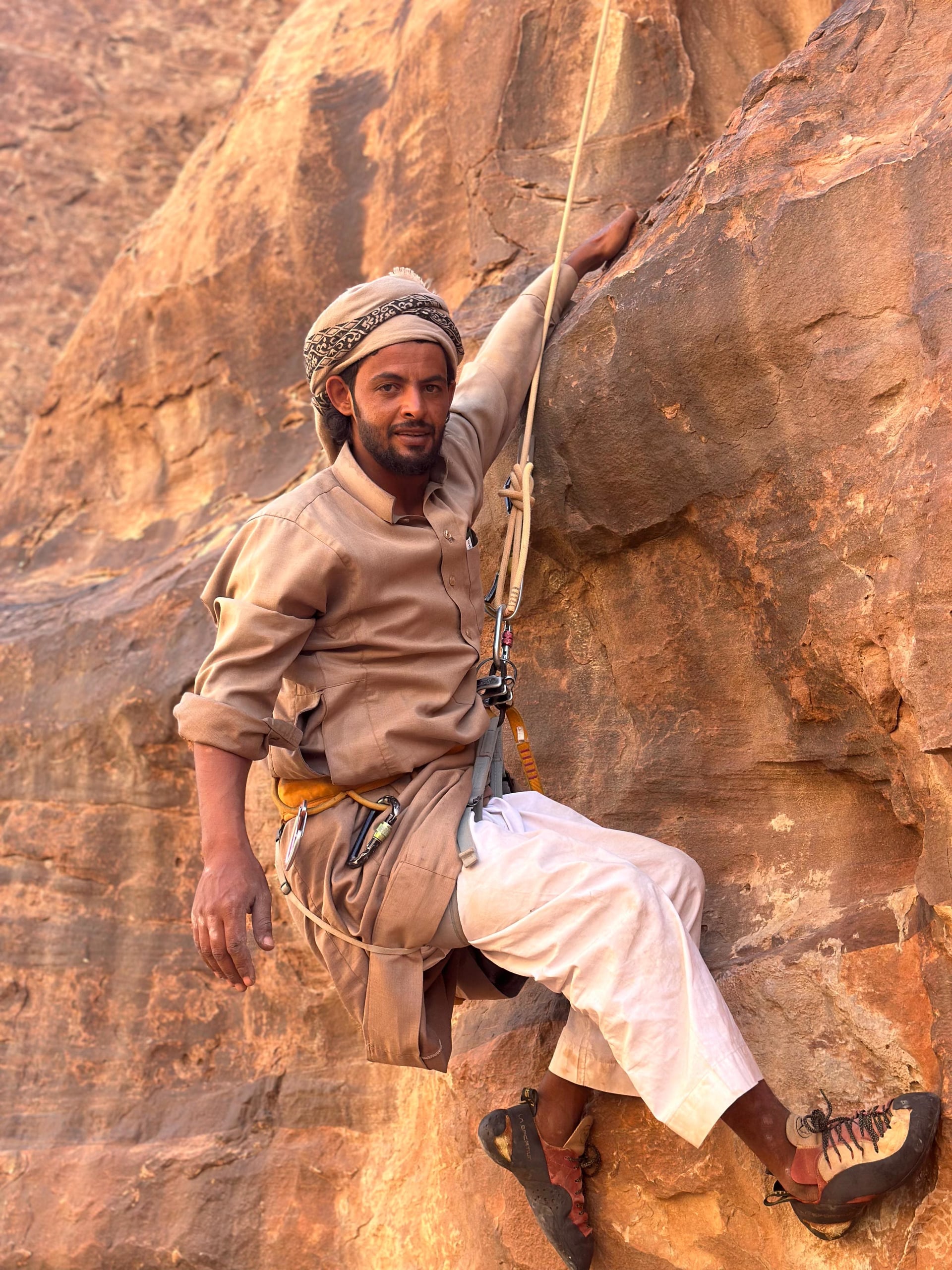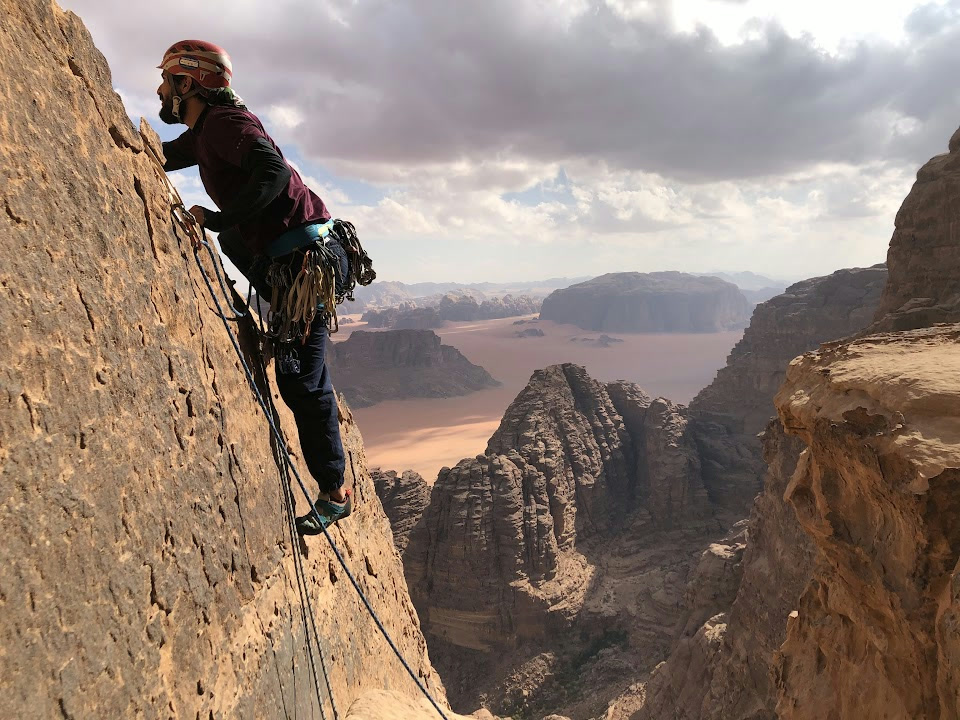In 1984, when Tony Howard's team arrived in Wadi Rum, the Bedouin had a test for them. It's a test we still use today-not to be cruel, but to teach an important lesson about respect, humility, and the true nature of these mountains.
The Setup
Tony's team had been shown various approach canyons where Bedouin hunting routes went to the mountaintops, including Jebel Rum. Then Defallah pointed out a huge cave, high in the east face.
"You can go there to the top. It's easy. It will only take you four hours. You won't need your ropes."
- Defallah Atieq to Tony Howard's team, 1984
Tony wrote: "Well, it didn't look that easy, but we were yet to learn that they had a climber's sense of humour."
The Reality
The team decided to take one rope between the four of them, "just in case." They were not surprised when the initial pitch turned out to be a VS (Very Severe) crack-not exactly "easy."
Into the Maze
They climbed up steep, exposed, and sometimes-overhanging cracks and chimneys, leading to a cavernous hole-initially high and wide, tapering down to body width with a thirty-meter roof. Tony described it as "a truly unique piece of rock architecture." He marvelled at "the Bedouin's ability to climb alone with only a rifle for company in such wild and exposed surroundings. Plus, if they were lucky, they would be climbing back down with an ibex on their back."
The team was happy to have a rope and wished they had two, which would have speeded up the climb. With time lost in route-finding, and climbing in a team of four, the supposed four hours was well gone when they emerged onto... not the summit of Jebel Rum. They couldn't even see it. They were simply above the East Face, directly above their camp.
The Realization: For the Bedouin, "the top" was simply the high plateau, home to the ibex. The actual highest point wasn't relevant to them - they were hunting, not peak-bagging.
The Great Siq Challenge
Just above was what they called the East Dome. They soloed up to its top, from where the true summit could be seen-but still a kilometer away. They were short on time but decided to go for it.
They were soon stopped in their tracks. The siq they had crossed on their ascent actually cut deep into the plateau-thirty meters wide and deep with vertical walls. No chance with their single rope.
The Mysterious Log Bridge
Hammad Hamdan had told them the siq narrowed and there was a log across it that ibex used. "There were even dead ibex in the bottom, below the log," he said.
They found human footprints going to the edge, but couldn't find the log or the narrows. Tony wrote: "In fact, we have never found either. Was it a Bedouin wind-up?"
(To this day, climbers debate whether the log bridge exists. Some say they've found it. Others think it's a Bedouin joke that's lasted forty years!)
The Unplanned Bivouac
By then they knew they weren't going to get back down that day. They hurried back over the East Dome, down-climbing their ascent route. It was slow progress.
An impromptu bivouac was inevitable, with:
- • No water left
- • No bivvy gear
- • No wood for a fire
- • A long, cold night ahead
The Welcome Committee
They arrived back at camp early the following morning with throats parched, much to the amusement of the Bedouin. A bunch of them were waiting: Defallah and his brothers, plus Hammad and Muhammad Musa.
"Where have you been?"
- The Bedouin, grinning
Tony's response: "Round one to them! But actually, they were right; once you know the way, four hours is possible, but there are few others who would climb and descend this complex 400-meter VS without ropes."
The Lesson
This wasn't cruelty-it was education. The Bedouin were teaching several important lessons:
1. Respect the Mountains
What looks "easy" from below can be complex and serious. The mountains demand respect, preparation, and humility.
2. Understand the Difference
The Bedouin could do this route in four hours, solo, without ropes. But they had:
- • Intimate knowledge of every hold and feature
- • Years of experience on this specific route
- • Knowledge passed down through generations
- • A lifetime of climbing barefoot on this rock
3. Learn to Listen
The test showed Tony's team that they needed the Bedouin. Not just for directions, but for the deep, internalized knowledge that can't be written in a guidebook.
The Climber's Sense of Humor
Tony wrote that the Bedouin had "a climber's pride in their routes; they pointed us towards them, giving only enough information to get us started, and were there to meet us on our return, grinning mischievously if we had been lost in the bizarre maze of these sandstone mountains."
He added: "We liked their climber's sense of humour."
This wasn't mean-spirited. It was the way climbers everywhere test each other-with challenges that teach respect and build camaraderie. The Bedouin were saying: "You want to climb our mountains? Prove you're serious. Prove you can handle it. Then we'll be friends."
We Still Do This Today
I'll be honest: we still test climbers sometimes. Not to be cruel, but to teach the same lessons. When someone arrives acting overconfident, talking about how they've climbed everywhere and know everything, we might suggest a "simple" route.
Usually, they come back humbled and respectful. And that's when the real partnership begins.
Climb with Humility
When you climb with me, I won't test you like this-unless you really need it! But I will share the same knowledge that my ancestors shared with Tony Howard. Come with respect and humility, and you'll learn things that can't be found in any guidebook.
Book Your AdventureThe Aftermath
After this experience, Tony's team approached every route with more respect. They listened more carefully to the Bedouin's advice. They prepared for longer days than expected. They brought bivvy gear "just in case."
Most importantly, they learned to "think like Bedouin hunters, who have learned to think like ibex." This deep understanding is what unlocked the mountains for them.
The test worked. Tony and his team passed. And the partnership that began with that humbling experience lasted for decades and continues to this day.
Source: This article is based on Tony Howard's first-hand account in "Quest into the Unknown: My Life as a Climbing Nomad" (Chapter 38), combined with oral histories from my family. All quotes are from Tony Howard's book, used with respect and attribution.


💬 Join the Discussion
Share your thoughts, experiences, or questions about this article